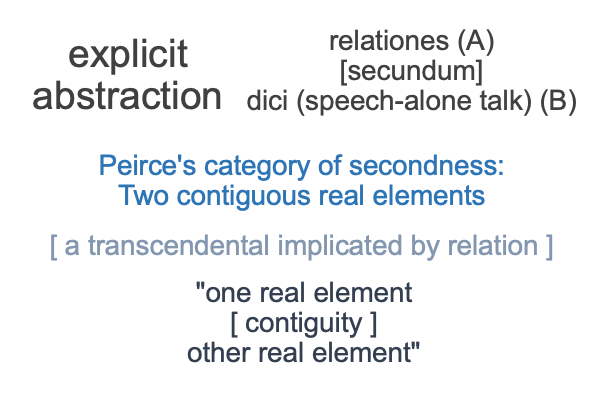0112 Of course, Duma does not go into such disturbing and discombobulating scenarios. Duma does not even mention Peirce. But, the last two questions frame a very important concern for philosophers.
The concern is not whether the theory of evolution is philosophically viable or not.
The question asks, “Given that human evolution consists of adaptations to the potential of triadic relations in the Lebenswelt that we evolved in, then what the hell is going on in our current Lebenswelt?”
0113 Peirce’s diagrams offer opportunities to express ways that implicit relations (as forms in the esse bucket, C) may be triggered when speech-alone talk (as a form in the dicey bucket, B) accords to explicitly configured relations (as matter in the dicey bucket, A).
Trust (implicit relation, C) the science (explicit relation, A).
0114 Ready for the next category?
The flow of A,B,C may start with Peirce’s category of secondness as explicit matter (A).
What is the corresponding explicit form?
Aristotle’s hylomorphe (B) exemplifies this category, consisting in two contiguous real elements. Here, the contiguity could hold the word, “transcendental”, because it applies to all expressions of secondness. The contiguity could also contain the word, “categorical”, for a specific application. For Aristotle’s hylomorphe, the first real element is “matter” and the second real element is “form”.

0115 Once again, dici (speech-alone talk), expessed as a diagram of a hylomorphic dyad, goes from form (in the dicey bucket, B) to matter (in the esse bucket, B). The corresponding form (C) consists of icons and indexes as sign-relations,as well as the logics applicable to expressions that belongs to Peirce’s realm of actuality. Actuality is subject to the (logics or) laws of contradiction and noncontradiction.

0116 An example?
Consider the actuality of a bridge (A), in a fancy high-rise hotel, spanning across the atrium. This construction should follow the laws of non-contradiction. In order to pass safety inspection, a little sign is placed at either end of the bridge, saying, “Only 100 people allowed.” This little sign (B) satisfies the attribution of this architectural thing to Peirce’s category of secondness (matter, explicit abstraction, A).
The two real elements to the relationes secundum dici (speech-alone talk) are the integrity of the bridge’s construction (A) and the safety limits placed on the bridge (B). The contiguity is [supports].
0117 Now, imagine a meeting of a philosophical society full of inquirers who know nothing of either Aquinas or Peirce. After the final academic session of the day, some wealthy donor throws a party in the atrium featuring the deep-state trance rave-master remixer named Crashing Success.
My pals say that the best place to watch the show is from the bridge suspended over the atrium floor. So, we go, and the bridge is already packed with fellow travelers. Lots of fellow travelers! But, right at the moment that I am about to step onto the bridge, I see the little sign: “Only 100 people allowed” (B).
So, I defer, and go back to the food court, while casting worrying glances at the party scene further down the atrium (not C).

0118 The transit from explicit (A) to implicit abstraction (C) intimates disaster.
For similar scenarios, see Looking at N.J. Enfield’s Book (2022) “Language vs. Reality”, appearing in Razie Mah’s blog for October 2024, as well as in Original Sin and The Post-Truth Condition Part 3 (available at smashwords and other e-book venues).
